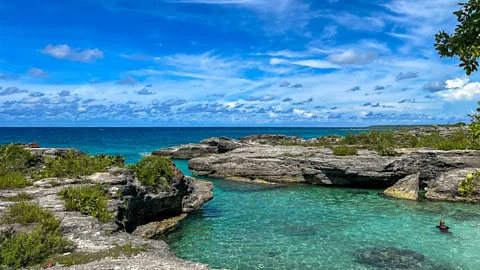
Photo Credit: Getty Images
This remote island, which was once known as a safe haven for pirates, is now an ecological hotspot and a Caribbean gem as It is home to some of the Caribbean’s rarest animals. It is now home to endangered Crocs, parrots, sharks, and turtles. Cuba’s Isla de la Juventud is a complete enigma. The Caribbean nation’s largest offshore island lies 60 miles south, of the main island and is a comma-shaped arch of palm trees, citrus groves, and marble hills that few visitors ever get to see.
In past centuries,real pirates used to dominate the islands coves, but today, visitors come from the port of Batabanó, which is south of Havana, on a three-hour ferry ride that requires bookings a month in advance.
Those who visit usually come to dive off the south-western tip (Punta Francés). Also, you get to tour the Panopticon Prison, where Cuba’s late communist leader was incarcerated in 1953 for attacking an army barracks,an event that triggered the 1959 Cuban Revolution.
Beyond its few attractions,the island’s soft beaches, unique culture and history, and protected wildlife have a different Cuban experience than the crumbling colonial facades and raucous rum bars of Havana.
Diving into the history of the island, in the late 1970s, Fidel Castro opened dozens of universities on the island for foreign students, and in 1978, the island was renamed Isla de la Juventud (the island of youth) from Isla de Pinos (the island of pines); however,the schools closed in the late 1990s, but their legacy remains in the island’s name.
Back when Columbus’ caravel sought water and wood on the island, his men glimpsed no other human soul. Ship logs say that the sea was “covered” with so many turtles of “vast bigness” and the air was thick with an “abundance” of birds, and “immense swarms of butterflies darkened the air.”.
If Columbus were to come back again today,he would still recognize much of the remote southern side of the island. A landscape patched up with swamps, mangroves, beaches, coral seas, limestone forests, and caves painted with prehistoric drawings,all safeguarded in the 1,455-square-kilometer region called south of the island of youth Protected Area of Managed Resources (APRM). Within this protected area, other vulnerable creatures, such as marine turtles, seek sanctuary in the sea.
To enter the protected areas, travelers must seek and obtain permission from the agency Ecotur or a local B&B and pass a checkpoint at the northern limit so that officials can monitor the trafficking of wildlife, people, and drugs.
Unlike other islands scattered around the Cuban mainland, the island of Youth is relatively undeveloped. Some locals claim the land is abandoned. However, within this castaway island, endangered creatures have sought refuge. Despite the fact that natural disasters, invasive species, overfishing, and climate change threaten its delicate ecological footprint, eco-minded visitors, Cuban scientists, and conservationists are setting a benchmark to ensure nature reclaims and thrives in this remote, secluded landscape.
Ig @mannu mwendwa.






















